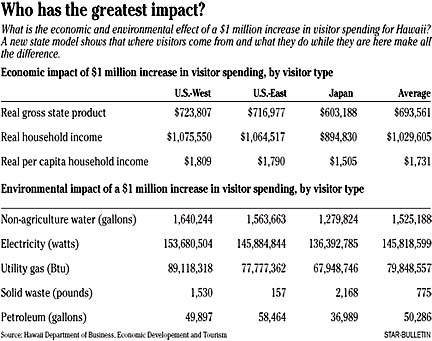
New research is being done on how more tourism in Hawaii might affect issues such as electricity use and waste creation. Among the visitors carrying purchases in Waikiki yesterday were Californians Trina Morris, above right, and Jennifer Juarez.
Study assesses
effect of tourismState researchers can
show which visitors use
more natural resources
If an ounce of prevention is really worth a pound of cure, Hawaii's visitor industry might be on the right track.
A benchmark computer modeling simulation revealed yesterday by the state is designed to help tourism planners estimate visitor impacts on the economy and infrastructure in terms of dollars, gallons, pounds and watts. It's also sophisticated enough to break down data by geographical area and by visitor region.
For example: If they were all to spend the same amount of money here, U.S. East visitors would create nearly 14 times less solid waste than visitors from Japan, and nearly 10 percent less waste than visitors from the U.S. West.
The U.S. East visitors also would use 4.7 percent less water, 5.3 percent less electricity and 12.7 percent less synthetic natural gas than their U.S. West counterparts.
And while Japanese travelers would create the most waste during their stay, they would use 22 percent less water, 7 percent less electricity and 14.4 percent less synthetic natural gas than their U.S. East counterparts.
The model uses economic data from 1997, the latest federal statistics available."It has great potential as a planning tool," said state Tourism Liaison Marsha Wienert. "It shows where we can get the biggest bang for our buck, with the least impact on our people, infrastructure and natural resources."
While a recent surge in visitors has brightened the outlook for Hawaii's economy, the good news has prompted tourism businesses, state officials and environmentalists to evaluate how increased arrivals could challenge the integrity of Hawaii as a viable destination in the future.
The simulation is the last installment in a $1.2 million state project, Planning for Sustainable Tourism in Hawaii, an effort to find specific impacts of tourism's growth on the island lifestyle, said Pearl Imada Iboshi, state economist.
"Rather than scrambling to fix problems, the model will allow us to think ahead," Iboshi said.
The model will allow state policy-makers to determine what infrastructure improvements will be needed if the state's visitor industry grows.
For instance, if planners plug in visitor information, the model shows that the higher-spending Japan and U.S. East markets potentially will have low impacts on state resources, she said.
The data also confirm that the average Hawaii visitor places more demands on the infrastructure than the average isle resident, using 49 percent more water per day and three times the electricity.
When it comes to making Hawaii tourism more sustainable, less could be more. It is important to find ways to increase visitor spending without taxing resources, said Sharon Weiner, board member of the Hawaii Tourism Authority."It's not about how many people arrive here; it's about how much they are spending," Weiner said. "What you want is fewer people spending more money."
Some members of the visitor industry, as well as members of environmental groups, hope that the state's new sustainable-tourism model will help decision-makers look more critically at growth.
"We are at the stage in our tourism development where we have to determine where we want to be when we grow up," Wienert said.
She said the model should help tourism find a balance.
Hawaii's natural resources provide a strong tourist draw, but the city and state have to limit access to these resources if they want to preserve them for future tourists and kamaaina, said Jeff Mikulina, Hawaii chapter director of the Sierra Club.
"Tourism is always going to have a role in Hawaii's economy. We just need to make sure that it's an appropriately sized role," Mikulina said. "We don't need to kill the goose that lays the golden egg, or we'll find tourists bypassing Hawaii in search of more pristine destinations."
Hawaii Tourism Authority
www.hawaii.gov/tourism


